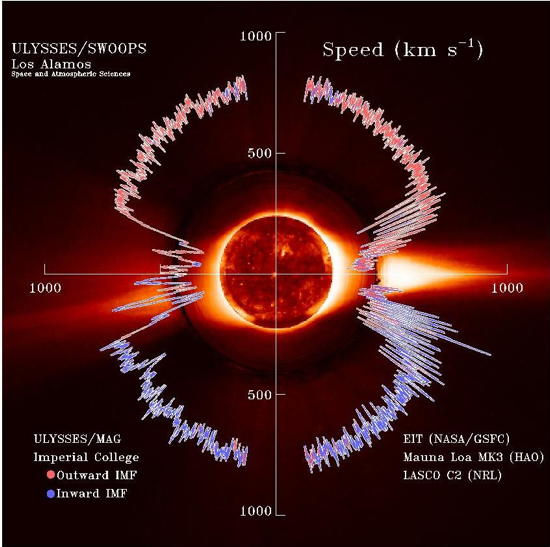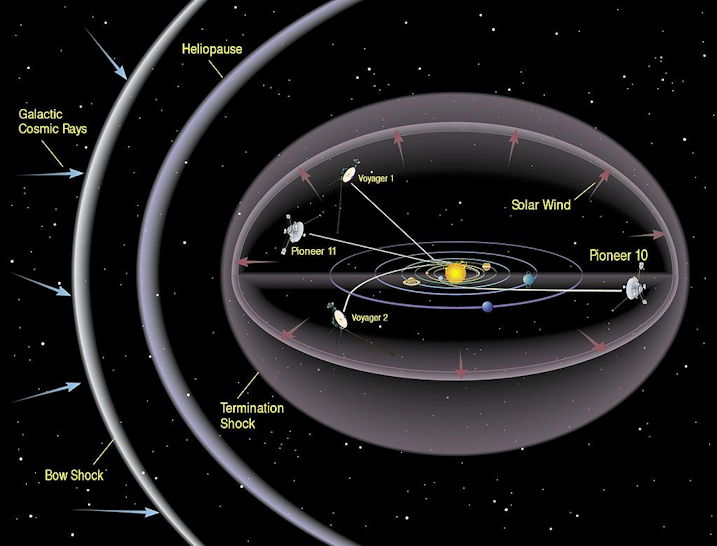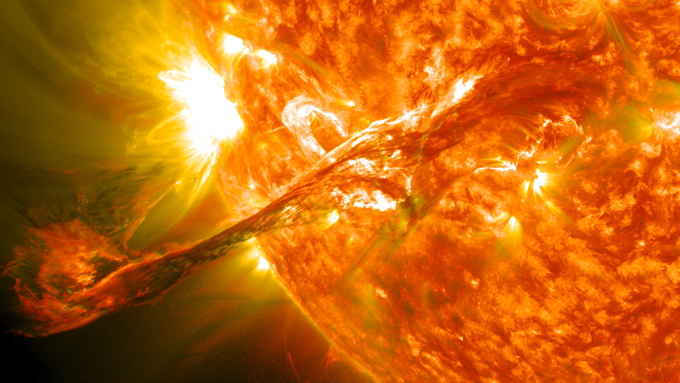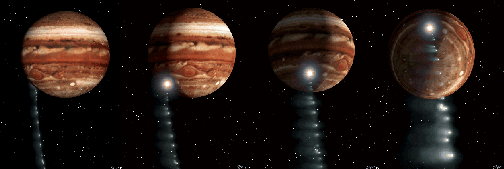BitsAside: stuff withdrawn from "Recycling the Universe"
David Noel
<davidn@aoi.com.au>
Ben Franklin Centre for Theoretical Research
PO Box 27, Subiaco, WA 6008, Australia.
Contents of this article
This article contains some less essential parts withdrawn from the full article, UG101: Recycling the Universe, to reduce its length.. These parts have have only a relatively small effect on the broader Universe Recycling picture. You can return to your original place in the "Recycling" article by clicking here or at the end.
Recycling Stuff2
There are a number of ways in which matter, Stuff2, is recycled within the Universe. Here we are looking ways in which atoms or ions are moved from or to bodies in space.
An important item here is when stars throw out atoms or particles into space, whether as a continuing stream, or in some irregular event. Most stars continuously emit matter -- in the case of our own star, this process is called the Solar Wind.
The Solar Wind
As well as light and other radiation, the Sun also sends out huge amounts of particles from its outer surfaces. These particles are mostly electrons and protons (hydrogen nuclei), with some alpha particles (nuclei of helium atoms). Here is some of what Wikipedia says [20].
"The solar wind is a stream of charged particles released from the upper atmosphere of the Sun. This plasma consists of mostly electrons, protons and alpha particles; embedded in the solar-wind plasma is the interplanetary magnetic field. The solar wind varies in density, temperature and speed over time and over solar longitude. Its particles can escape the Sun's gravity because of their high energy, from the high temperature of the corona and magnetic, electrical and electromagnetic phenomena in it."
"The solar winds flow outward supersonically at varying speeds, depending on their origin, reaching up to around one million miles per hour. [They reach] to great distances, filling a region known as the heliosphere, an enormous bubble-like volume surrounded by the interstellar medium."
"The solar wind is divided into two components, respectively termed the slow solar wind and the fast solar wind. The slow solar wind has a velocity of about 400 km/s and a composition that is a close match to the corona. By contrast, the fast solar wind has a typical velocity of 750 km/s and it nearly matches the composition of the Sun's photosphere. The slow solar wind is twice as dense and more variable in intensity than the fast solar wind. The slow wind also has a more complex structure, with turbulent regions and large-scale structures."

Figure UG101-F8. Speeds of the Solar Wind. From [20].
"The slow solar wind appears to originate from a region around the Sun's equatorial belt that is known as the 'streamer belt'. Coronal streamers extend outward from this region, carrying plasma from the interior along closed magnetic loops. Observations of the Sun between 1996 and 2001 showed that emission of the slow solar wind occurred between latitudes of 30 and 35 degrees around the equator during the solar minimum (the period of lowest solar activity), then expanded toward the poles as the minimum waned. By the time of the solar maximum, the poles were also emitting a slow solar wind."
"The fast solar wind is thought to originate from coronal holes, which are funnel-like regions of open field lines in the Sun's magnetic field. Such open lines are particularly prevalent around the Sun's magnetic poles."
According to [21], solar wind flow amounts to about 300,000 tonnes each second. This seems enormous, at almost 10 trillion tonnes per year, but this is only 1 part in 1014 of the solar mass -- about a hundredth of a billion-billionth each year.
In other words, if the Sun continued to put out its Solar Wind at the current rate, it would be about 100 billion billion years before all its mass was gone. As the Sun is believed to be no more than 5 billion years old, this movement of Stuff2 from our star contributes only a tiny amount of the build-up of matter in interplanetary space.
The Solar Wind peters out as it reaches the edge of the Solar System, a vast spheroid called the Heliosphere, of radius about 100 AU (1 AU is the distance from the Sun to the Earth). This is well past the planets -- the outermost one, Neptune, is about 30 AU out. The Heliosphere is a real boundary, beyond which conditions change, as has been shown by the Voyager Space Probes which have passed through its envelope.

Figure UG101-F9. The Heliosphere. From [22].
There is more about the Heliosphere and the Solar Wind in P4: The Greater Averaged Universe [11]. .
Solar Flares and CMEs
As well as the Solar Wind, which flows continuously, from time to time the Sun emits huge bursts of material called Solar Flares over relatively short periods. The flares contain both radiation over most bands, and also particles. Here is some of what it says in [23].
"A solar flare is a sudden flash of brightness observed near the Sun's surface. It involves a very broad spectrum of emissions, requiring an energy release of typically 1020 joules of energy, but flares can emit up to 1025 joules (the latter is roughly the equivalent of 1 billion megatons of TNT, or over 400 times more energy than released from the impact of Comet Shoemaker-Levy 9 with Jupiter).
Flares are often, but not always, accompanied by a coronal mass ejection. The flare ejects clouds of electrons, ions, and atoms through the corona of the sun into space. These clouds typically reach Earth a day or two after the event. The term is also used to refer to similar phenomena in other stars, where the term Stellar Flare applies."

Figure UG101-F10. On August 31, 2012 a long prominence/filament of solar material that had been hovering in the Sun's atmosphere, the corona, erupted out into space. It caused an aurora on Earth on September 3. From [23].
"Solar flares affect all layers of the solar atmosphere (photosphere, chromosphere, and corona), when the plasma medium is heated to tens of millions of Kelvin, while the cosmic-ray-like electrons, protons, and heavier ions are accelerated to near the speed of light.
They produce radiation across the electromagnetic spectrum at all wavelengths, from radio waves to gamma rays, although most of the energy is spread over frequencies outside the visual range, and for this reason the majority of the flares are not visible to the naked eye and must be observed with special instruments.
The frequency of occurrence of solar flares varies, from several per day when the Sun is particularly 'active' to less than one every week when the Sun is 'quiet', following the 11-year cycle (the solar cycle). Large flares are less frequent than smaller ones."
So Solar Flares produce both electromagnetic radiation (Stuff1) and streams of particles (Stuff2). These flares come out from different spots on the Sun's surface, and are not confined to the plane of the planets.
Another way in which the Sun emits material is a CME. A coronal mass ejection (CME) is an unusually large release of plasma and magnetic field from the solar corona. CMEs often follow solar flares and are normally present during a solar prominence eruption. The plasma is released into the solar wind [24].
CMEs most often originate from active regions on the Sun's surface, such as groupings of sunspots associated with frequent flares. Near solar maxima, the Sun produces about three CMEs every day, whereas near solar minima, there is about one CME every five days.
Coronal mass ejections reach velocities from 20 to 3,200 km/s with an average speed of 489 km/s. These speeds correspond to transit times from the Sun out to the mean radius of Earth's orbit of about 13 hours to 86 days (extremes), with about 3.5 days as the average. The average mass ejected is 1.6 x 1012 kg. Although quoted figures on mass or energy of CMEs appear quite large, in fact they are negligible compared to those of the Sun or other stars.
Big and little accumulations
We know that the Earth is in in continuous receipt of bodies falling from space, most notably in the form of meteorites. According to [26], estimates for the mass of material that falls on Earth each year range from 37,000 to 78,000 tons. Most of this mass would come from dust-sized particles.
We also know from the existence of meteor craters on Earth that much larger bodies have occasionally impacted. One of the larger ones was the "Chicxulub impactor", which hit an area of the Yucatan Peninsula in Mexico about 66 million years ago [28]. The crater was formed by a large asteroid or comet at least 10 km in diameter. The crater is more than 180 km in diameter and 20 km deep.
As for other planets, in 1994 the pieces of a large comet were observed and photographed when it hit Jupiter.

Figure UG101-F12. Collision of comet with Jupiter. From [27].
According to [27], "From July 16 through July 22, 1994, pieces of an object designated as Comet P/Shoemaker-Levy 9 collided with Jupiter. This is the first collision of two solar system bodies ever to be observed. Comet Shoemaker-Levy 9 consisted of at least 21 discernible fragments with diameters estimated at up to 2 km".
If the Earth is subject to a continuing fall of objects from space, then the other planets and the Sun may be expected to also gain mass in this way. No larger bodies have ever been observed to fall into the Sun, but recently observed comets have made it close to the sun's surface. In 2011, comet Lovejoy actually passed through the solar corona, emerging much the worse for wear but still loosely together. Comet ISON barely survived a similar trip in 2014 [25].
These occurrences lead to gains in the masses of celestial objects from their surrounding space. In the shorter term, they are normally a negligible part of mass recycling in a solar system. They can be regarded as part of the mechanisms by which planets clear their orbits from minor space objects.
In the longer term, measured in hundreds of millions or billions of years, these gravitational interactions may profoundly affect mass balances in wider space. Our typical picture of, say, a Solar System like ours is that it evolved out of a "protoplanetary disc" of matter surrounding the early Sun, which contained all the constituents of the current planets in their current positions.
Loss and gain of gases
Before leaving the topic of Stuff2 transfer, we should look at the movement of gases and other particles, still basic matter but in the form of atoms or molecules rather than bodies. Generally these transfers, involving such things as the atmospheres of planets, are fairly small in total mass when compared to masses of planets and stars.
We have already seen that our Solar Wind and related things like Solar Flares are continuously pushing tiny particles out into the far reaches of the Heliosphere, out to the outer Solar System. Some of our planets, and a few of the moons circling them, have gaseous atmospheres. The atmospheres we see today are the result of processes which have taken place over many years, and may be quite different to those of a planet's youth.
Escape velocities of gases
Gaseous particles in space are subject to gravity wells like that in Figure F11, just as are planets or stars. When you look at the gaseous envelopes of planets, their atmospheres, there are a few special considerations.
Whether a planet retains an atmosphere or not, and whether an atmosphere changes over long ages, mostly depends on the escape velocity of the planet involved, and the planet's distance from the Sun. A planet's escape velocity increases with its mass.
Generally speaking, smaller planets closer to the Sun will lose atmosphere more quickly than bigger and more distant planets. Lighter gases, those with lower molecular weights, will go first because their molecules move faster and are more likely to exceed the planet's escape velocity.

Figure UG101-F14. Atmospheres of the planets and gas molecular weights. From [34].
Figure F14 shows how the molecular weights of gases affects their retention in a planet's (or moon's) atmosphere. The lightest gases, Hydrogen (Molecular Weight=2) and Helium (MW=4) have been lost from all planets except the cold Gas Giants, distant from the Sun.
However, when Hydrogen is combined with other elements, such as Water (MW=18), Ammonia (MW=17), or Methane (MW=16), it can be retained as long it isn't too liable to be broken down in the atmosphere. Heavier gases such as Oxygen (MW=32), Nitrogen (MW=28), and Carbon Dioxide (MW=44) are fairly easily retained by the larger inner planets. Mercury and the Moon have essentially lost their atmospheres.
This is a simplified picture, and doesn't take into account various factors which are usually forgotten from textbooks. Mars once had much water and oxygen in its atmosphere. Earth developed life, which changed its atmosphere markedly, with free oxygen and a huge percentage of its carbon trapped as carbonates. On planets such as Venus and Earth, planetary expansion has continually increased the amount of mantle re-worked into crust, with accompanying release of water and other gases.
There is more detail on this matter at
The Earth's Atmosphere [NU011] [33].
Gaining gases from interplanetary space
Space around the planets does contain a measurable amount of hydrogen. Gravitational attraction will mean that a planet may pick up some of this hydrogen as it orbits around the Sun.
A calculation has been done [29] to see whether hydrogen loss or gain by the Earth is significant in determining the balance of water (sea volume) on an expanding Earth.
The working result was an annual gain of about 7x108 kg of neutral hydrogen. While this is extremely small compared to the mass of the Earth, and is only a first-approximation result subject to various riders, it is still about 700,000 tonnes per year -- not that much short of a million tonnes.
Moreover, as the hydrogen would be only one-ninth of the water created by it picking up oxygen, the theoretical water gain would be about 6.3 million tonnes.
You can return to your original place in the "Recycling" article by clicking here.
* * * * * * * * * * * * * * * * * * * * * * * *

References and Links
[1] Isaac Newton. https://en.wikipedia.org/wiki/Isaac_Newton .
[2] The Electromagnetic Spectrum. https://www.flickr.com/photos/advancedphotonsource/5940581568.
[3] Terence Witt. Our Undiscovered Universe. p.361. Aridian Press, 2007. See also [30] .
[4] Gamma-ray burst. https://en.wikipedia.org/wiki/Gamma-ray_burst .
[5] Radio telescope. https://en.wikipedia.org/wiki/Radio_telescope .
[6] Infrared telescope. https://en.wikipedia.org/wiki/Infrared_telescope .
[7] Parkes Observatory. http://www.csiro.au/en/Research/Facilities/ATNF/Parkes-radio-telescope/Parkes-Observatory-Visitors-Centre/Hours-location .
[8] Ultraviolet astronomy. https://en.wikipedia.org/wiki/Ultraviolet_astronomy .
[9] Where do cosmic rays come from? http://www.hep.ph.bham.ac.uk/general/outreach/SparkChamber/text5h.html .
[10] David Noel. P3: Living In The Universe. http://www.aoi.com.au/Living/ .
[11] David Noel. P4: The Greater Averaged Universe. http://www.aoi.com.au/GAU/index.htm .
[12] Fraser Cain. What is the cosmic microwave background radiation?. http://phys.org/news/2014-03-cosmic-microwave-background.html .
[13] About Cosmic Microwave Background Radiation. http://www.bbc.co.uk/science/space/universe/sights/cosmic_microwave_background_radiation .
[14] David Noel. P2: The Oort Soup as the real origin of Cosmic Microwave Background Radiation . http://www.aoi.com.au/OortSoup/index.htm .
[15] David Noel. Temperatures of the Earth -- a Globe in Space (a re-analysis with some surprising results). http://www.aoi.com.au/bcw/EarthTemp/index.htm .
[16] Standard 1 & 2 EOL Review on emaze. https://www.emaze.com/@AOTZCRZI/Standard-1-&-2-EOL-Review- .
[17] Atom. https://en.wikipedia.org/wiki/Atom .
[18] Periodic Table Of Elements With Names And Symbols. http://removeandreplace.com/2015/09/09/periodic-table-of-elements-with-names-and-symbols/ .
[19] Atom Structure - Universe Today. http://www.universetoday.com/56747/atom-structure/ .
[20] Solar wind. https://en.wikipedia.org/wiki/Solar_wind .
[21] Michael W Friedlander. Cosmic Rays. Harvard University Press, 1989.
[22] Paul Glister. Heliospheric Crossings (and the Consequences). http://www.centauri-dreams.org/?p=9654 .
[23 Solar flare. https://en.wikipedia.org/wiki/Solar_flare 7 .
[24] Coronal mass ejection. https://en.wikipedia.org/wiki/Coronal_mass_ejection .
[25] What would happen if a massive comet crashed into the sun?. https://www.newscientist.com/article/dn27954-what-would-happen-if-a-massive-comet-crashed-into-the-sun/ .
[26] How many meteorites hit Earth each year?. http://curious.astro.cornell.edu/about-us/75-our-solar-system/comets-meteors-and-asteroids/meteorites/313-how-many-meteorites-hit-earth-each-year-intermediate .
[27] Comet Shoemaker-Levy Collision with Jupiter. http://www2.jpl.nasa.gov/sl9/ .
[28] Chicxulub crater. https://en.wikipedia.org/wiki/Chicxulub_crater .
[29] How much interplanetary hydrogen could the Earth sweep up? http://zombal.com/zomb/scientific-question/how-much-interplanetary-hydrogen-could-the-earth-sweep-up .
[30] Terence Witt. Null Physics, Part 4: Cosmology. http://www.nullphysics.com/downloads/NULLCOSM.pdf .
[31] Yarkovsky effect. https://en.wikipedia.org/wiki/Yarkovsky_effect .
[32] David Noel. P1: The Cosmic Smog model for solar system formation, and the nature of 'Dark Matter'. http://www.aoi.com.au/bcw1/Cosmic/index.htm .
[33] David Noel. The Earth's Atmosphere [NU011]. http://www.aoi.com.au/NUSite/NU011.htm .
[34] Modelling an airless Earth. https://tallbloke.wordpress.com/2014/08/27/extending-a-new-lunar-thermal-model-part-ii-modelling-an-airless-earth/ .
[35] The life and death of a star. http://kotaku.com/5924866/the-evolution-of-stars-the-unusual-astronomy-of-mass-effect-halo-and-starcraft-ii .
[36] Stellar evolution. https://en.wikipedia.org/wiki/Stellar_evolution .
[37] The Death of Stars I: Solar-Mass Stars. http://www.atnf.csiro.au/outreach/education/senior/astrophysics/stellarevolution_deathlow.html .
[38] The Death of Stars II: High Mass Stars. http://www.atnf.csiro.au/outreach//education/senior/astrophysics/stellarevolution_deathhigh.html .
[39] What is the Smallest Star?. www.universetoday.com/25348/what-is-the-smallest-star/ .
[40] Neutron star. https://en.wikipedia.org/wiki/Neutron_star .
[41] Neutron Star. https://www.pinterest.com/explore/neutron-star/ .
[42] These Amazing Neutron Star Facts Will Blow Your Mind. http://www.buzzle.com/articles/neutron-star-facts.html.
[43] Crab Nebula. p.361. https://en.wikipedia.org/wiki/Crab_Nebula .
[44] David Noel. Inside The Earth -- The Heartfire Model. http://www.aoi.com.au/bcw/Heartfire/index.htm .
[45] David Noel. Finally, the True Origin of Earthquakes? http://www.aoi.com.au/bcw1/Finally/index.htm .
[46] Pulsar. https://en.wikipedia.org/wiki/Pulsar .
[47] Black hole. https://en.wikipedia.org/wiki/Black_hole .
[48] John Michell. https://en.wikipedia.org/wiki/John_Michell .
[49] John Michell. http://pics-about-space.com/john-michell-black-hole?p=3#img11494485399856746759 .
[50] Schwarzschild Radius. astronomy.swin.edu.au/cosmos/S/Schwarzschild+Radius .
[51] Astrophysical jet. https://en.wikipedia.org/wiki/Astrophysical_jet .
[52] Monster Black Hole Is Biggest Ever Found. http://www.space.com/18668-biggest-black-hole-discovery.html .
[53] Slide 43 -- The Eye of the Beholder. http://slideplayer.com/slide/1416294/ .
[54] Milky Way's Central Bulge. http://www.solstation.com/x-objects/cenbulge.htm .
[55] Galactic Gamma-ray Emission. http://imagine.gsfc.nasa.gov/Images/satellites/cosb_gcem.gif .
Go to the AOI Home Page
First version of full article, 1.1, on Web 2016 Dec 9. These extracts (BitsAside V. 1.2) withdrawn to reduce size of the full article, on Web 2017 Jan 4.







